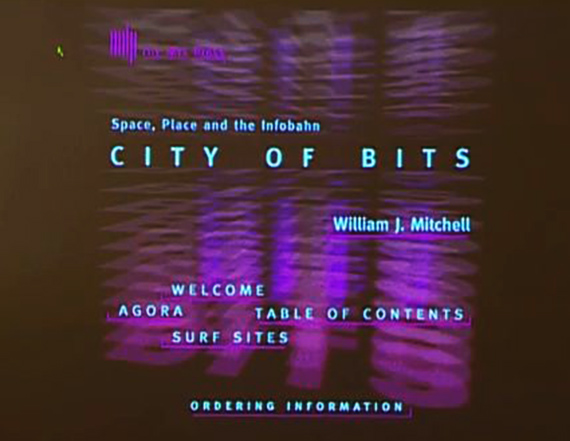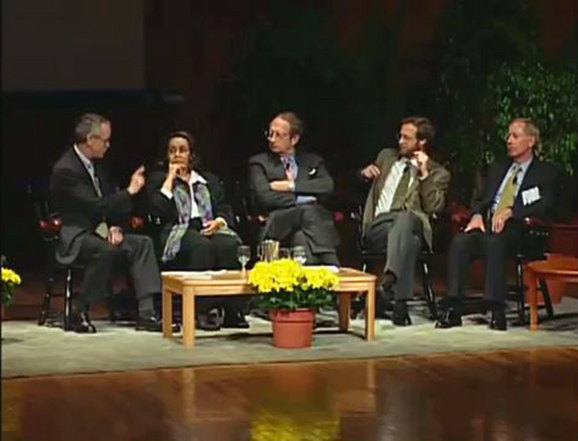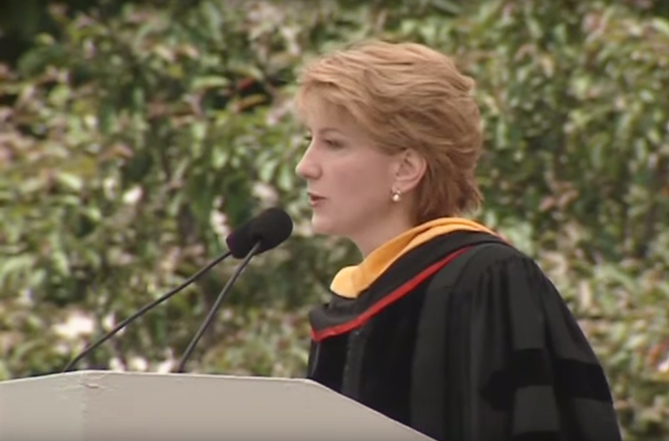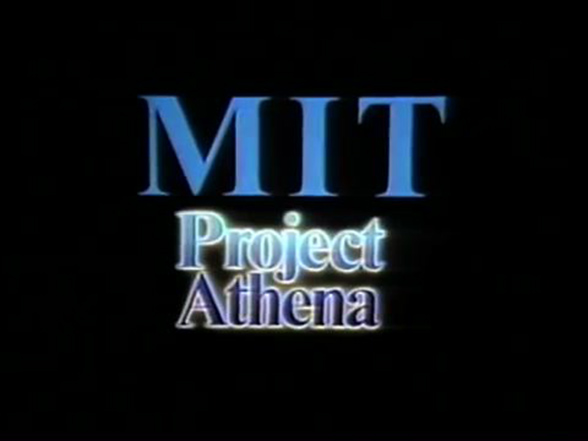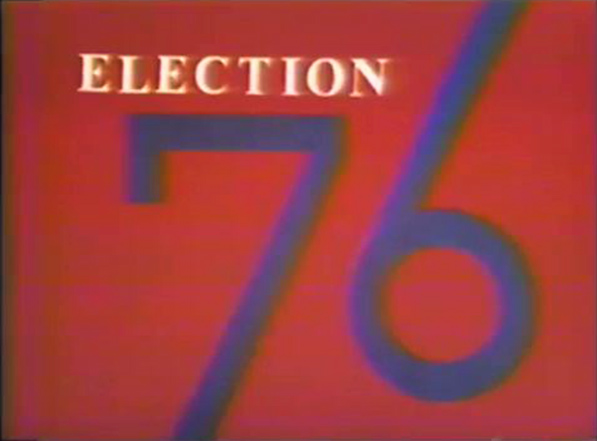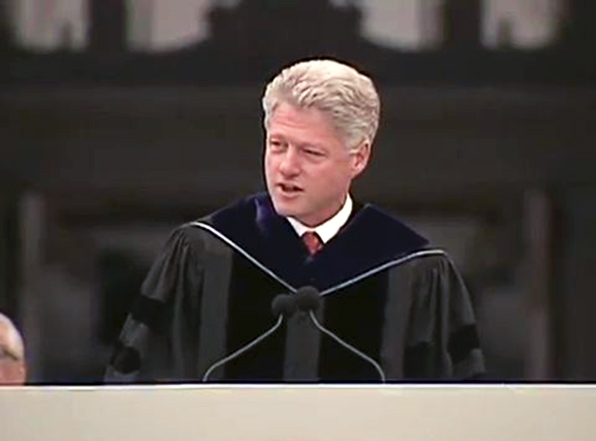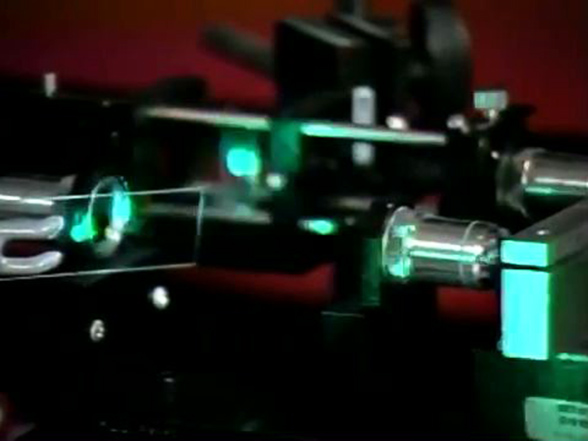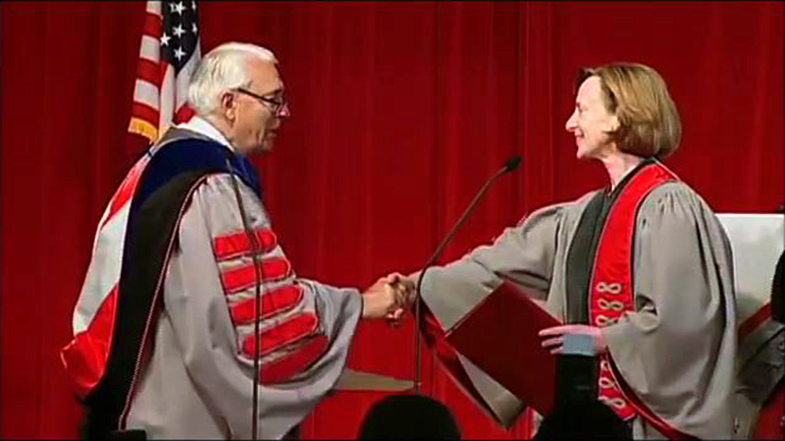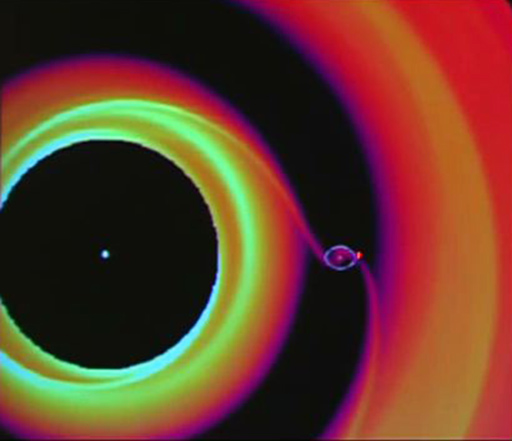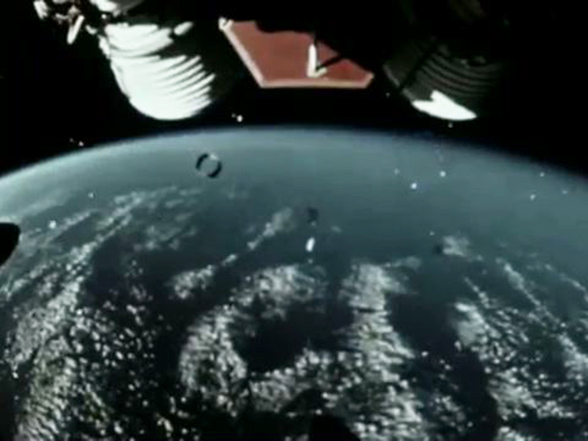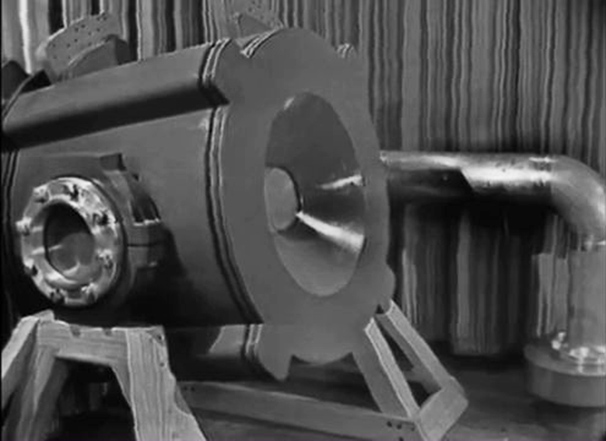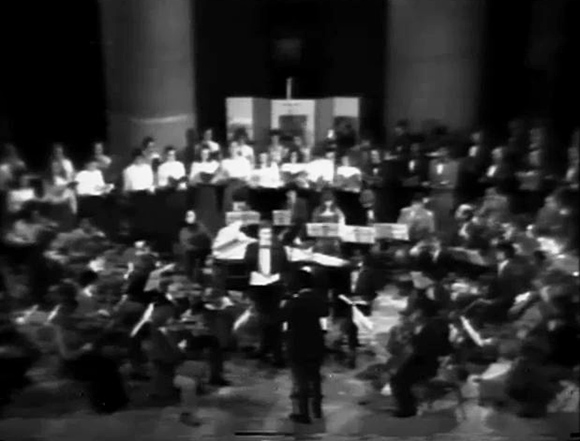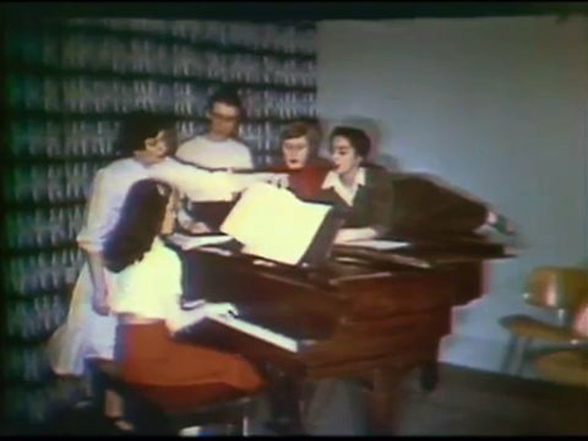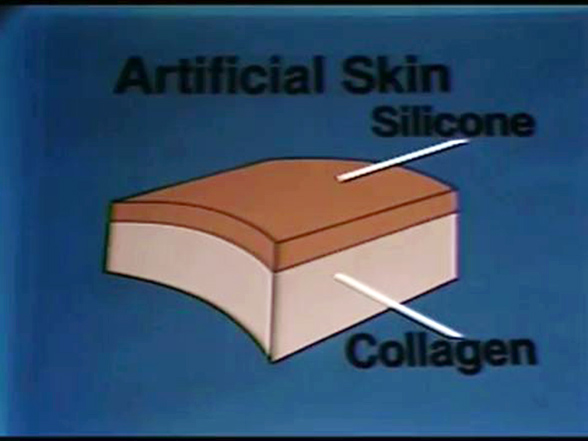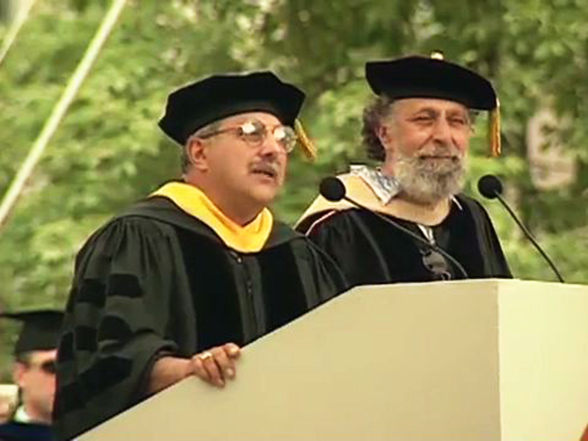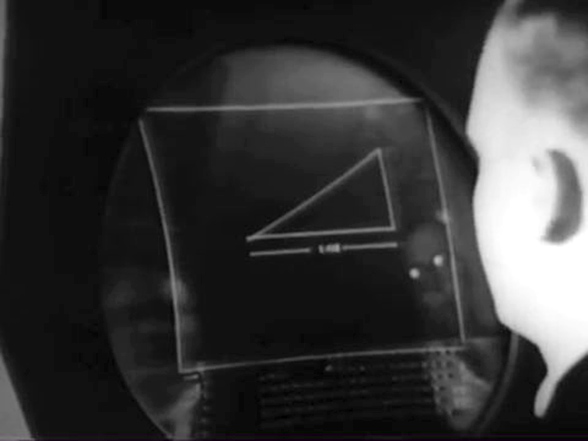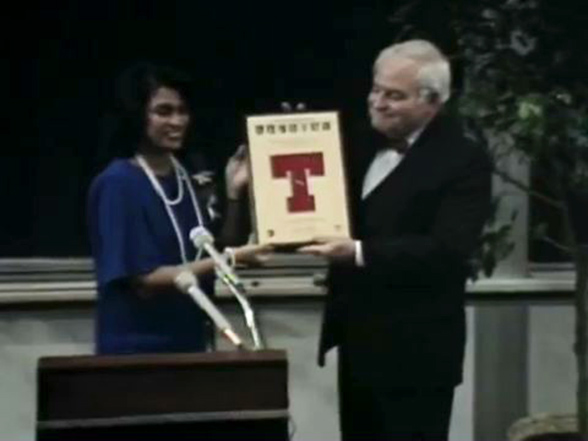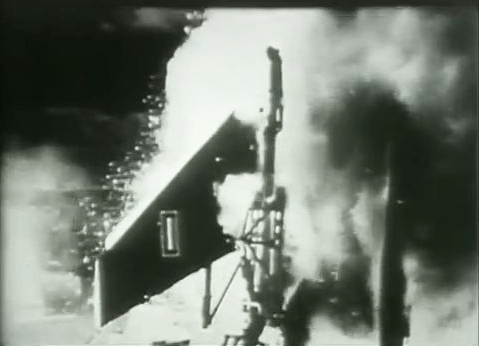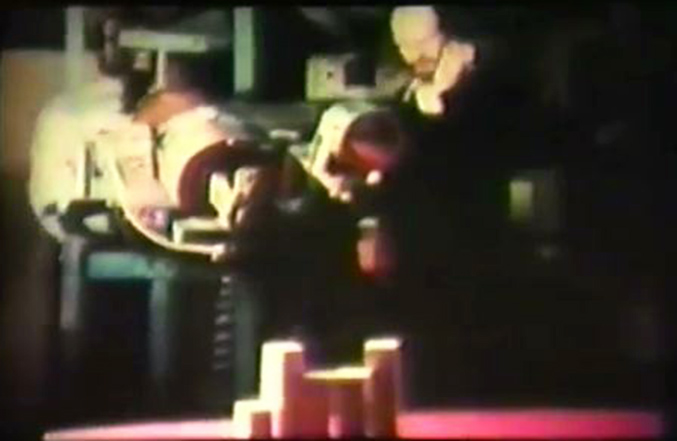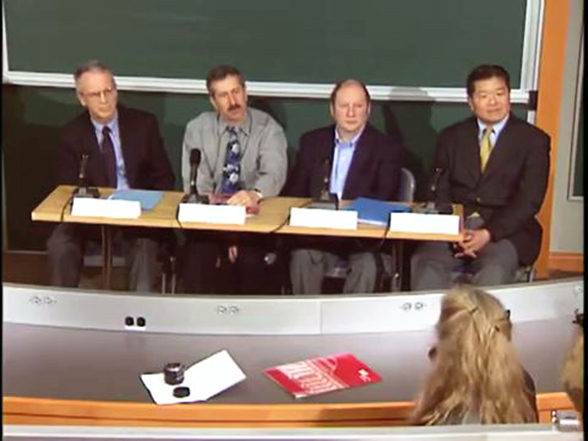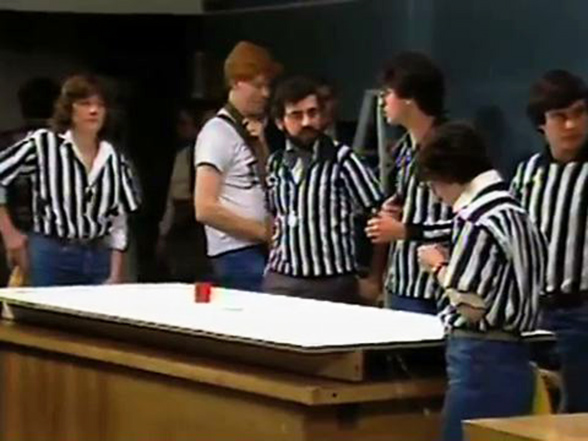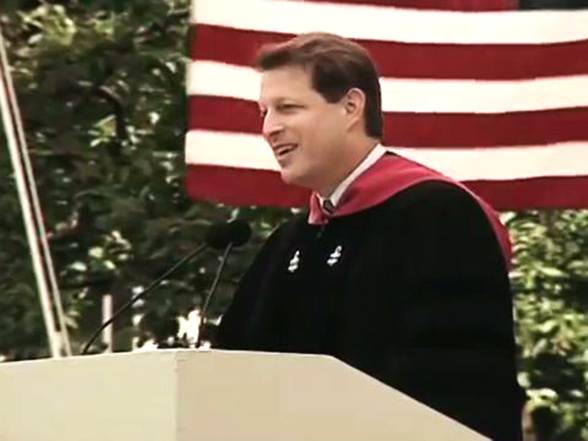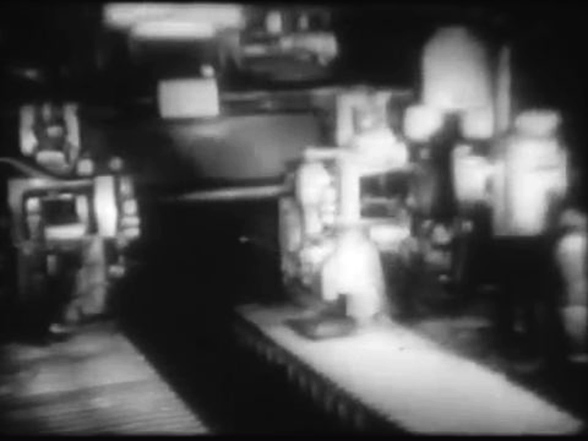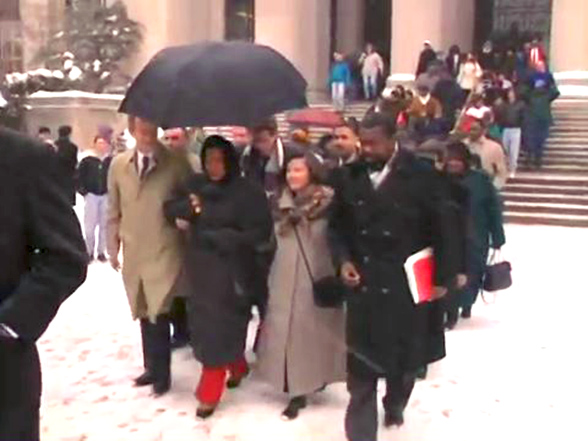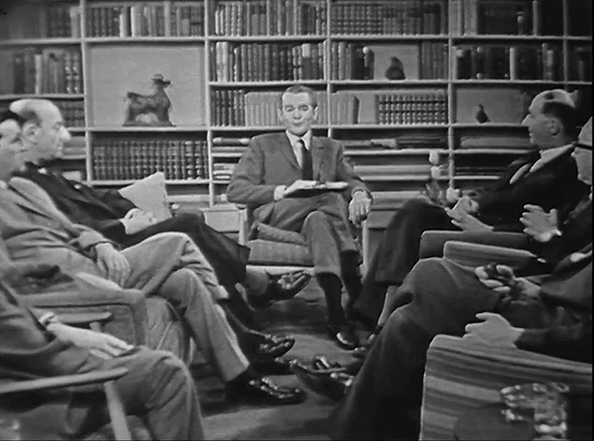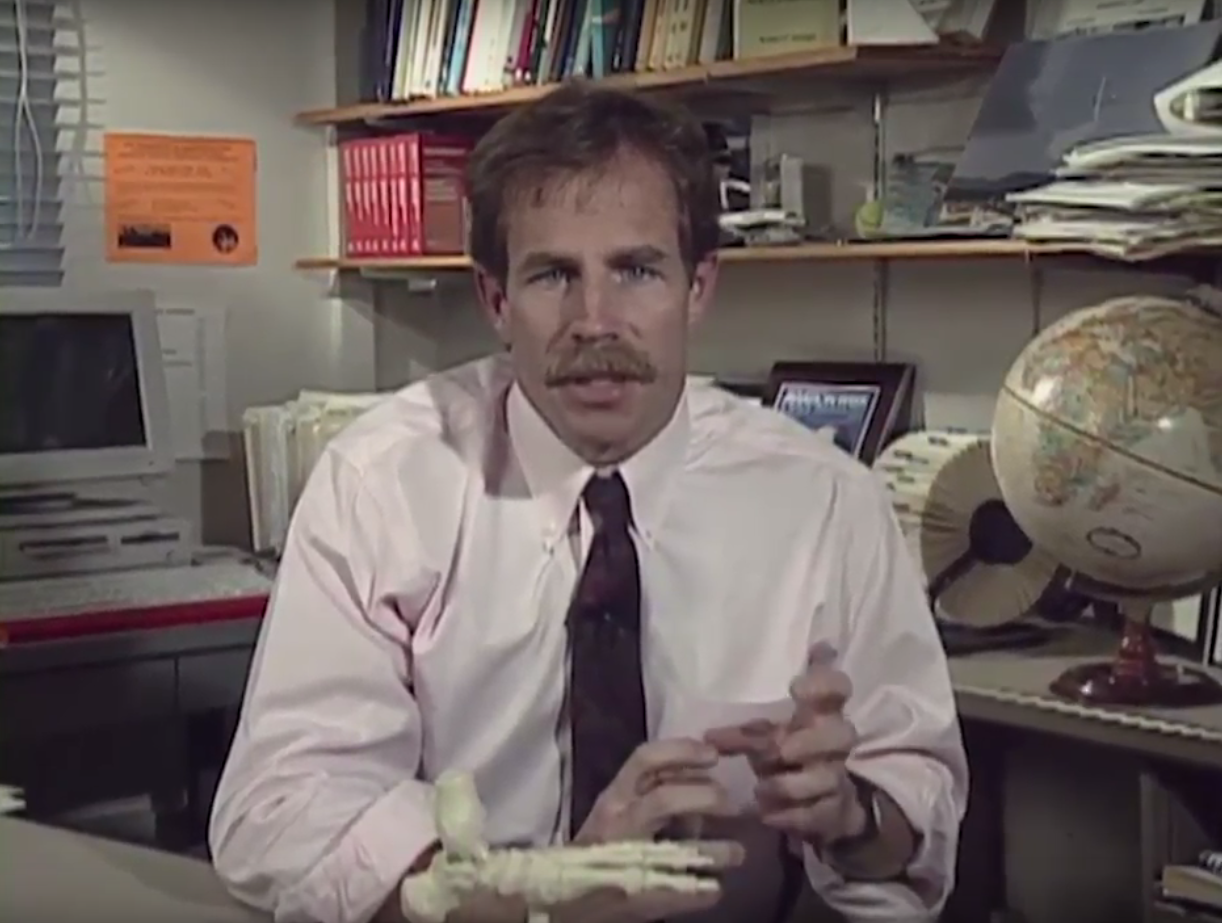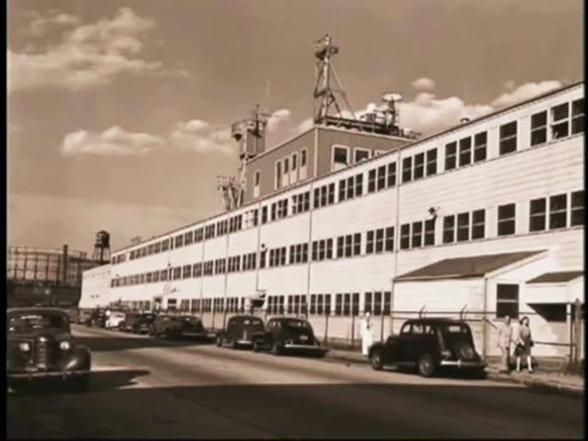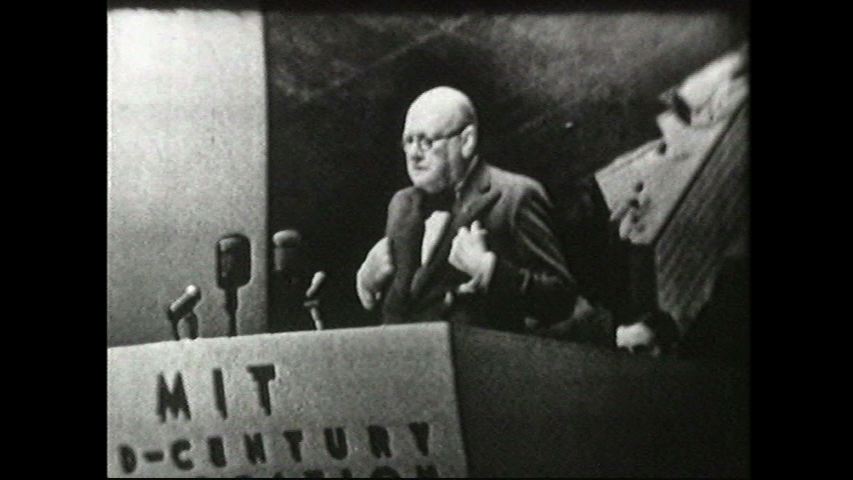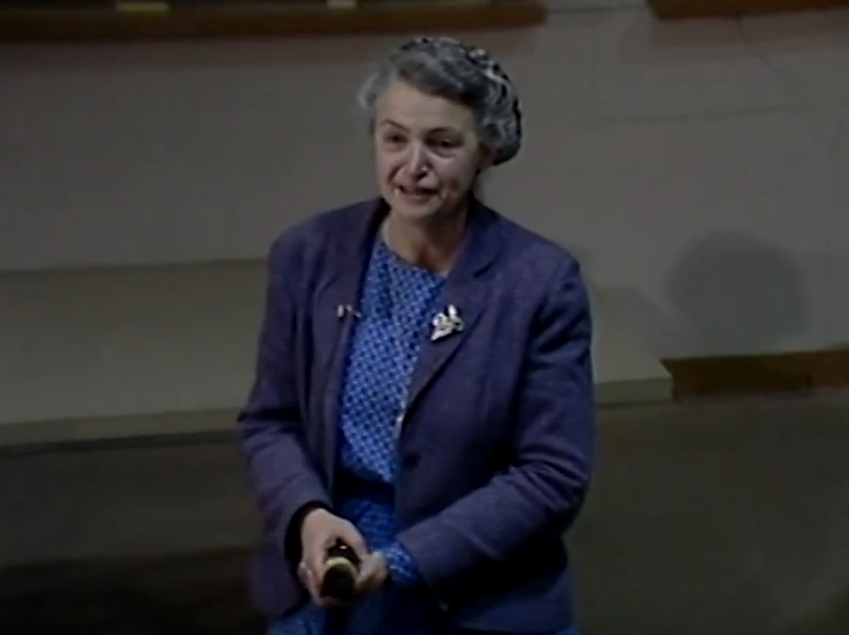MIT Science Reporter—"EDM: A Magic Slate" (1962)
FITCH: --kind of corporation that has been emerging in America during the past 15 years. A corporation built entirely on modern photographic and electronic technology and designed to deal with the mid-century phenomena of computers and automation. Today, the MIT Science Reporter visits ITEK, to take a look at one of these new research-based companies in action.
We'll examine a computer that can communicate in the speedy, easy language of pictures. ITEK calls it EDM. We call it the Magic Slate.
[MUSIC PLAYING]
Hello, I'm John Fitch, MIT Science Reporter. Very glad to be back with you once again. Right now, I'm in the large drafting room of the ITEK Corporation, which is just off famous Route 128 in Lexington, Massachusetts, and I'd like to show you something.
Now, this man is working on a large printed circuit diagram. Typical of such diagrams, it requires a great deal of work to produce this finished drawing, perhaps 60 days and as much as 600 man hours might go into a drawing like this. And yet, as you can see by looking at it, it's quite repetitive. There are only three or four elements, which are repeated over and over again.
It all has to be hand drawn very accurately, inked in. And all of this requires a great deal of time. And of course, time is money. I know from my own experience how surprised I was the first time I handed a group of sketches to a draftsman to turn into finished product, just how much time and money was charged to an engineering project just through this kind of drafting.
Well, you can imagine it would be pretty wonderful if we could have some sort of a machine to do this kind of drafting. Well, this is a problem that ITEK has been working on for about a year and a half. And just about three weeks ago, they announced success.
It took a team of some 20 people working on this project continuously, and they were all under the direction of one of the vice presidents of the ITEK Corporation, Mr. Norman Taylor, whom I'd like to have you meet now. Mr. Taylor, we want to thank you for letting us come to visit ITEK, and also see this particular machine. How did you happen to get started on building a drafting machine?
TAYLOR: Well, the whole aim of the ITEK Corporation's goal in information technology is to do something in the graphic information area to complement what has been done in the digital information area in the last 10 years. And we are quite interested in doing something to help the human being with this problem in graphics. Because most people do communicate with graphics. In fact, when most people try to use a digital computer, they find themselves surrounded by what we call a man-machine barrier.
FITCH: What do you mean by that?
TAYLOR: Well, digital computers, which are perhaps the best tool for manipulating information that has come along the pipe, use binary numbers and binary bits. We have a little tape here. This is the typical way that the binary numbers are inserted into such a computer.
FITCH: So that's the only kind of language that the computer itself understands.
TAYLOR: That's right.
FITCH: It understands numbers, or really understands holes in a piece of paper tape.
TAYLOR: That's what it comes down to, right. And you heard that people can write programs using letters and numbers. And each one of these holes, or group of holes, is one letter in a word that you tell a computer what to do next, you see.
However, there's so many things that people do when they communicate with each other that don't fit this pattern too well. A good example of this is if I were to try to tell you how to get to my house. Let's just consider this, if I were going to tell you over a telephone. And here, of course, I'd have to use words.
FITCH: That would be like trying to talk to the computer, because you can't show it something.
TAYLOR: You can't show it something. You see, I'd take an example. I'd have to tell you to get on Route 93, and travel north on 93 until you cross Route 128. At this point, continue on 93 for 2.1 miles, and then take a right turn onto Route 111. Continue down 111 for one mile, and take a rather button-hook curve to the left, and look for a little store on the corner. And then proceed up a street called Grove Street for a mile. And then look for an island in the middle of the road, and so on and so on.
FITCH: I had a very clear picture of how to get to your house from that.
TAYLOR: You see, what happens is, you're going to call me back and say, why don't you drop a little map in the mail, so I'll know how to get there? And here you have an example of a man needing to use graphic communication to tell another man what he wants. One we--
FITCH: Give me another example of that sort of thing.
TAYLOR: Well, yeah. Let's suppose that I wanted to tell you how to draw an American flag. Now, you know what I'm going to tell you, because you're familiar with an American flag. But if we were going to discuss this over the telephone, I would have this problem of saying, well, why don't you pick up a pencil, and go to the left lower hand corner of the screen, and start drawing a horizontal line. And then, let's say, draw it eight inches, and then go up a quarter of an inch, and draw a horizontal line in the other direction.
And I tell you these detailed instructions, as you go up through the flag, and where the stars were, and so on. Eventually, you'd be able to draw an American flag from my instructions. Of course, you'd sort of know what you were doing, so you'd fill in the things I forgot to tell you.
Now, just for fun, we actually coded up this instruction and gave it to a computer, to tell it to draw an American flag. And here I have a list of the instructions that it took to draw a simple thing, like an American flag.
FITCH: All this?
TAYLOR: All of this.
FITCH: For Heaven's sakes. Pages and pages of, of course, just numbers, which is the kind of information that the computer can understand.
TAYLOR: Yeah. And so I think this gives you an example of a man-machine barrier. You see, we want to do a thing like draw an American flag, and we have to go through all this rigmarole to do it.
FITCH: And then was the machine able to draw an American flag from that?
TAYLOR: Yes. As a matter of fact, here's a picture of what the machine produced as a result of having these instructions given to it in the usual binary way.
FITCH: I'm not sure that everyone is familiar with the fact that computers nowadays can actually draw pictures as an output. We think in terms of a computer usually typing out a lot of numbers, such as we saw.
TAYLOR: Yes. This has been the usual output. However, in the last few years, both applied machines and cathode ray scopes have been hooked on to computers. And if they're so instructed, they can make pictures of this sort as an output medium.
FITCH: Well, this is all very well, to draw American flags or maps, but surely you developed this for some other purpose.
TAYLOR: Yes. Now, as we start to think about engineering problems in a more broad sense, we find the typical example of a graphic communication is a wiring diagram of this sort. Now here, you see, if I were to change this to how to draw this, over a telephone, if you will, I would really have trouble. Because in the first place, you would have no idea where I was trying to tell you about. And each one of these lines is now a curve, and it goes to a specific place. So the number of instructions necessary to tell a computer how to do this become rather large.
FITCH: One thing that I don't understand, really, Mr. Taylor, is why would you want to communicate a diagram like this to a computer in the first place?
TAYLOR: Well, now you're getting to the heart of the matter. This is a very good question, because obviously, it seems easier to just draw the thing and be done with it. But a computer has certain manipulative powers that are very interesting to people in the designing area or in the area of-- well, we want to be quantitative about what we want to do.
For instance, on this diagram, it might be very interesting to know how long each one of these lines is after we have it drawn. What the spacing is between the wires. What the tolerance factors are. And these problems become quite quantitative, and the computer is a peculiarly good device for helping you along with this kind of information.
FITCH: I suppose once it is stored inside a computer, you could enlarge it or reduced it in size, too.
TAYLOR: Oh, yes.
FITCH: Or maybe even take out wires or [INAUDIBLE]
TAYLOR: Yes, it's very flexible. The manipulative power is very useful, here. We can compare this drawing with other drawings or call drawings from file that we've made before and make modifications on them, you see, with a great deal of flexibility.
FITCH: And I suppose also, it's a convenient way to store information.
TAYLOR: Very much so.
FITCH: Well, now you've given me a good reason for wanting to communicate with the machine in this way, but I don't really see quite how you're going to do it. As I understand it, we have-- you can talk in terms of numbers, digits, that's what the machine understands, and a few English words, perhaps. But what about lines and things like that?
TAYLOR: Well, in order to answer this question, I think we'd better go to the basic ingredients that are used in making up a drawing like this. If we approach a drafting table, we find that there are three basic tools that a draftsman uses to make any kind of drawing. You're familiar with a t-square, and you're familiar with a compass, and the French curve, for making curves.
And it turns out, on thinking about the matter, that any kind of diagram, whether it's a drafting or a graphic chart of any sort, is made up of these three basic building blocks. Now, if we look at this chart here, we find that each of these building blocks, the t-square, the compass, and the French curve, is related in a very simple way to a very simple equation, which as you mentioned before, is the language of the computer.
FITCH: Yes. But it seems to me, now you're right back where you started from. You're going to use mathematical equations, then you've got to have mathematicians to interpret these diagrams to the machine.
TAYLOR: Very true. And now we come to the part which is new and different, which allows us to overcome this problem.
FITCH: Oh? Well, I'll be happy to have you explain that.
TAYLOR: Well, here we have a TV set. Now, we're not going to talk about using cathode ray tubes in the usual way, because that isn't the way the computer uses cathode ray tubes. We're going to start talking about cathode ray tubes in a rather new way. Now, you remember at night when you turn off your TV set, there's a little bright spot, appears in the middle of the scope?
FITCH: Yeah.
TAYLOR: Now, this particular spot is a very useful device to us, because if we can capture this spot, with a thing called a light pen, we may be able to exercise some control over where that spot is located.
FITCH: This is a light pen?
TAYLOR: That's a light pen.
FITCH: It looks very much like an ordinary pen.
TAYLOR: Mm-hm. Well, you've probably not been used to a light pen. It isn't a new device, but it's a very useful one. Instead of having a ballpoint or an ink source in the tip, we have a photoelectric cell. And by attaching the photoelectric cell through the light pen to a computer, we are then in a position to capture the light spot. The same one, in fact, that you see at night, when you turn off the TV set. And then, by capturing it, it will follow the light pen with the aid of the computer on a cathode ray tube.
FITCH: So you actually move the spot around the face of the scope, and then that automatically puts the information into the computer?
TAYLOR: Right.
FITCH: So now we're using-- in the recent past, we've had the cathode ray tube as a means of displaying what was in the computer. Now we're using it to actually put the information into the computer.
TAYLOR: Yes. And that is the important thing to remember. That we not only have an output device, but we also have an input device. And now we have a way of getting a two-way communication with a computer.
FITCH: And putting graphic symbols, I mean, lines and curves and circles, putting them in directly, instead of having to put them into mathematical terms first.
TAYLOR: Yes. And none of this punch paper tape or any of that business anymore.
FITCH: Well, I think we're about in a position now to see the actual machine itself. I'm kind of excited about it, and I hope we can see it.
TAYLOR: Well, Miss Pat Gordon is standing by-- one of our staff-- and let's go in the computer room and see her.
FITCH: Good.
GORDON: We're in the computer room now. I'd like to show you around. Back here, way back in back, is the computer which we use to perform all the operations of the drafting machine. And over here is the cathode ray scope, on which we draw with the light pen to communicate with the computer.
This is light pen itself. Alongside here is the plotter, on which we make a permanent record of what we've drawn on the scope. For our demonstration today, my colleague Frank Fredericks will operate the drafting machine.
FREDERICKS: Well, thank you very much, Pat. Now, can we actually see how the graphic machine works?
GORDON: Yes. I thought we'd show you the simple elements first, before we move on to the others. First, Frank is going to draw a line, a horizontal line. You notice that he can move the pen around almost anywhere, and yet he gets a horizontal line.
FITCH: Why is that?
GORDON: This is because he has asked for a horizontal line by depressing the function button marked horizontal.
FITCH: Oh, with his left hand. I see. Yes.
GORDON: With his left hand. You notice also that the line continually varies. Its length is variable, and the line is not fixed until he releases the button, at which point the line is permanently recorded on the scope until it is erased and within the computer memory. Similarly, you can draw a vertical line.
FITCH: I notice that the computer waits a second or so to make sure that he stopped before it actually draws the line--
GORDON: That's right.
FITCH: --for him. Mm-hm.
GORDON: With a slant line however, there's another option. He can change the angle, as well as the line, at will.
FITCH: Well, after he's paused, then the system draws a line to the place that he stopped.
GORDON: That's right.
FITCH: I'd point out an interesting fact at this time, that the scope is used then, really, to communicate with the machine, in that it's used for both entering the information and then displaying what you've decided on.
GORDON: That's right. We've just drawn lines, and we don't know how long they are. But the computer, for instance, can tell us how long they are.
FITCH: All right. Let's ask it, then.
GORDON: Yes. And here we'll now tell it how long the line is. This line. The one that Frank just pointed to.
FITCH: Mm-hm. Oh, I see. It actually prints out the length of the line in inches to three decimal places.
GORDON: That's right.
FITCH: And draws a conventional arrow just as though it were-- a draftsman would.
GORDON: That's right. That's right.
FITCH: Well, that's very interesting, because that information is in there, stored, more or less incidental to drawing a line, but it's a-- you can print it out and have it there displayed, available to you.
GORDON: Well, if you've drawn a diagram, and then are curious about what you've done, it's very handy.
FITCH: I can well imagine.
GORDON: We can also draw circles in the way we drew lines. First, specify your center point and indicate that you want a circle. The radius is defined by the degree to which-- by the place to which you've drawn your pen.
FITCH: Yes. Again, it waits just a second. It makes sure you've paused, and that's where you want the circle.
GORDON: That's right. Circles can be modified, as well as all output can be modified. Suppose Frank doesn't want the circle and decides he wants an arc. He indicates with his light hand, the endpoints of the arc, as you can see him doing now. And tells the computer that he wants an arc. And the circle is modified to give an arc. It's really quite simple.
FITCH: When you say simple, maybe for somebody like Frank, but do you mean that I could learn how to operate this?
GORDON: Yes. I think you could learn how to operate it.
FITCH: Frank, move over. I can't resist a challenge like that. I see I've got a clean magic slate to work with.
GORDON: OK. You'll need both hands. That's right.
FITCH: I'm going to need both hands. Now, if you'll hold the microphone. Now, what do I do?
GORDON: Now just take your pen and draw, while keeping the light or the ink with you.
FITCH: All right. I've got it captured, I guess.
GORDON: All right. Now, just draw. And you get the feel of it in a minute or two.
FITCH: Uh-huh. All right. Now, suppose I wanted to draw a horizontal line from here.
GORDON: Well, you choose your endpoint. And if you've chosen that as your point, depress the button marked horizontal line, and now you can start to draw.
FITCH: I can't seem to draw a very horizontal one, but-- well, how about that? Oh, there it is.
GORDON: There it is. And releasing the button, that line is recorded in the computer.
FITCH: Uh-huh. And how about a vertical line?
GORDON: Draw a vertical line. This is the vertical button.
FITCH: All right. Oops, I lost the-- all right. That's not very vertical, but--
GORDON: And there it is.
FITCH: And there it is. And a circle.
GORDON: Pick your center point.
FITCH: Okay. There's a good one.
GORDON: And you would press this button.
FITCH: Marked "compass." All right.
GORDON: And now pull up. Don't let go until you've got the circle that you want.
FITCH: All right. There it is. I'll make it a little smaller, I think.
GORDON: Okay.
FITCH: Well, that's fascinating. [CHUCKLES] Frank, you better come back in her and take over again. That really is fairy simple, even for me. What about some of the more complicated things?
GORDON: Well, we have some very powerful function, which we will show you right now. For instance, drafting work can be very tedious and repetitive. And you may have to draw something four or five or six times.
But we have a function called reflect, in which you can reflect copies of what you've drawn. This saves your drawing, for instance, all four parts of a wheel, or all four parts of a particular diagram which is symmetrical by two axes. And Frank is now going to draw several lines and reflect.
FITCH: So to make a mirror image?
GORDON: That's right.
FITCH: I see. This is-- what he's drawing then is just a quarter of what he wants as a finished product.
GORDON: That's right.
FITCH: Well then, this is one of the-- what you call the manipulative functions of this system, which makes it so much more than just a means of drawing straight lines and circles.
GORDON: That's right. He's now going to reflect a copy of that little area about that particular line. And now he will reflect this whole drawing about this line that he's now pointing to.
FITCH: I see. Over the horizontal axis. And now he'll have a [INAUDIBLE]. There it is.
GORDON: Now he's drawn some sort of mechanical diagram, and it's complete. But it's lacking in details, and we may be curious about the details, and we want to see them. Well, there's a way that we can blow up, magnify, certain parts of the drawing to fit in various details. And this is done-- we're going to magnify this drawing, a section of it, eight times. And this is done by reducing the frame, these lines, eight times and then blowing it up.
FITCH: Oh, I see the frame getting smaller and smaller. Right. All right. What is he doing now?
GORDON: Now he's moving the frame to the area of the drawing in which he wants to draw his detail in.
FITCH: Oh, it's much like an inset on a map, isn't it?
GORDON: And he can move them anywhere. That's right.
FITCH: And you mean, what's inside that frame now, he's going to magnify?
GORDON: That's right.
FITCH: Well, that's interesting. Well, that might be very useful, now that I think about, for a draftsman. Oh, there's that little section of H, or whatever it was that you would call that. That might be a mechanical part, like a hinge, or something like that.
GORDON: That's right.
FITCH: And this might be some small detail in it. What are you drawing there, a cross?
FREDERICKS: Yes. That's probably the center of the drill hole.
FITCH: Oh, that might be for drilling a hole? All right.
GORDON: Now.
FITCH: It's much easier to draw something small like that in this enlarged version. I suppose it would be very difficult if you had to work in the actual normal-scale size.
GORDON: That's right. Now you see it's restored to they way it was before, but with detail drawn in. This is a very powerful function.
FITCH: I should certainly say so.
GORDON: Similarly, suppose you wanted to draw, for instance, a second coy of this particular mechanical object. And you wouldn't want to go through this whole process again. Well, all he has to do is just move a copy of it.
FITCH: Oh, I see.
GORDON: And it's reproduced exactly.
FITCH: There's a second one.
GORDON: There's our second copy.
FITCH: Maybe if he hadn't drawn it so big, he might have been able to fit it right in next to it, or something like that.
GORDON: That's right. Now--
FITCH: That would certainly eliminate one thing that I mentioned earlier in the program, which when looking at one of the printed circuit diagrams, the fact that so much of it was repetitive. This eliminates it. You just halved the amount of work.
GORDON: That's right.
FITCH: Cut it in half.
GORDON: That's right.
FITCH: By repeating it.
GORDON: That's right.
FITCH: Well, can you make that remove that one?
FREDERICKS: Yes, I can.
FITCH: Well, this is another-- you can add a second copy, and you can take it away.
GORDON: That's right. And now, for instance, we have this mechanical diagram here, but we want to send, say, a copy to the machine shop, to have it made up. Here is where we use our plotter to record exactly what we've drawn on the scope. And we can send as many copies as we want to the machine room, or to conference rooms, or wherever we want. And we always have this hard copy.
FITCH: Hmm. Well, and I'll move over here a little bit and get out of the way. And there goes the plotter. Rolling up some fresh paper, first.
Now, I think you can see on your screen that we are showing the oscilloscope pattern, the original, on the left hand side. And on the right hand side of your screen, you see the plotter making this exact copy, sort of rotated 90 degrees here, sideways. But at any rate, it is an exact copy of what is shown on the oscilloscope.
And Frank, can you move it a little bit? Yes, there's even the little cross in that corner. And we now have a permanent record of the original pattern that we had on the oscilloscope. Well, I suppose if you made one copy, Pat, you could make as many as you want.
GORDON: That's right. It could go on for as many as you wanted.
FITCH: And this also provides a very nice permanent storage of a given pattern, so that you could use it or call for it later. Very, very, very interesting. Well, thank you both very much. Pat, Frank. Appreciate it.
GORDON: You're welcome.
FREDERICKS: Thank you.
FITCH: Most interesting demonstration. In the few minutes we have left, I'd like to talk to Mr. Taylor once again. This is, I understand, a rather informal set up. It's still an early stage of the development of the drafting machine. How long will it be before you'll have a machine that an engineer or a draftsman can actually use?
TAYLOR: Well, of course we've learned an awful lot, going this far, with this engineering model. And we're starting to design the production model of this machine now. In fact, we have a mock-up right here of the console that the draftsman will use, or anyone who wants to use it for any other application. And we expect to have this working model available in about 14 months. [INAUDIBLE] system.
FITCH: Well, will it be fairly complicated? In other words, the fact that Frank was able to use it quite simply, but the [INAUDIBLE] seemed to me a lot of little buttons and holes and special things that he was doing.
TAYLOR: Well, we feel the complication of using this machine is very similar to that one faces when learning to use a typewriter. You have about the same number of buttons. And the facility with which you can learn to use it will be comparable to that used in learning the typewriter business.
FITCH: So an engineer or a draftsman should be able to learn it.
TAYLOR: Well, yes. In fact, we're quite sure that because of the skill needed to teach-- it takes quite a while to teach a draftsman to be an artist, you see.
FITCH: That's true.
TAYLOR: And much of the artistry will be removed. In other words, one will able to be a draftsman with less artistry.
FITCH: Well, will the system handle all the different problems that are involved in engineering drawings and drafting?
TAYLOR: Well, when you say all, of course you encompass quite a lot. We do feel that it'll handle many of the problems that we now know about, and some of the things a draftsman is most confused about will be added to his capability.
FITCH: For instance?
TAYLOR: Well, when he wants to find a part which he has to add to his drawing, we can have this part stored as a part of the catalog of drawings which the computer has access to. And he can call these parts up. And he won't have to draw them. They will have been drawn previously. And call them on his scope, and add them to his drawing. So in many ways, we will save him time by him just not having to make the drawing at all.
FITCH: Well, it seems to me that a system that's as fundamentally new as this is certainly going to have applications outside the field of mechanical drawing.
TAYLOR: Well, I wanted to mention that to you, because we're finding that this machine has got so many applications that it's even hard to talk about them in the few minutes we have. But one of the more interesting ones is in the area of city planning or road planning. I have here a picture, an airplane picture, of an airport. This is Bedford Airport, which is just around the corner, I believe.
And one of the problems in such a development is to plan roads, draw roads and study the buildings that are associated with such a development, as you can see here, on these pictures. Now, if we made a copy of this, a negative, such as this sort of thing, so we could see through it, and put it over-- overlaid it on our scope, we could then take our light pen here, and I think if you-- you can see that you can easily copy there the peripheral outline of a building or a road. Then you see we have been able to insert this graphics and get the information into the machine.
FITCH: Well, thank you very much, Mr. Taylor, for this opportunity to visit ITEK and to see this fascinating machine, the Magic Slate. Thank you again. Certainly, a most interesting machine, and one that's going to open up a whole new field of communication with a computer in an age when a computer is of such paramount importance.
Now, next week, we're going to take a look at the night sky at the Harvard Observatory. Our guest will be Patrick Moore, a man who has his own program, television program, on astronomy, on the British Broadcasting Corporation. And he's going to help us take a look at some of the tools of the astronomer's trade. And we'll also take a look at the stars themselves. This is John Fitch, your MIT Science Reporter. I hope you'll be with us then.
[COMPUTER BEEPING]

